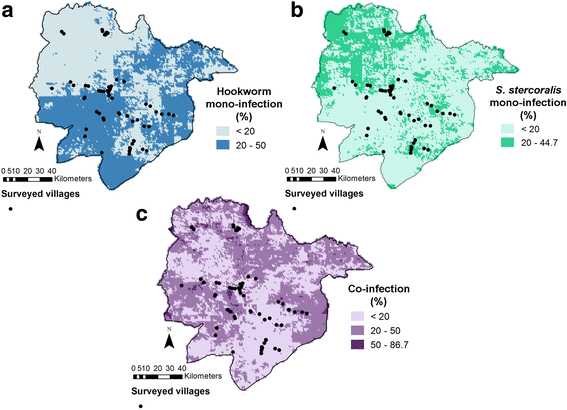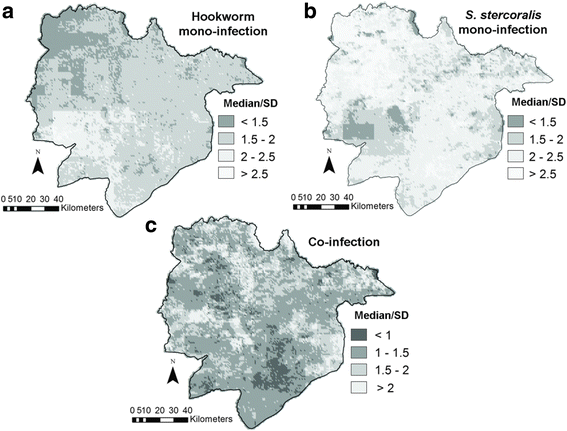Strongyloides stercoralis and hookworm co-infection: spatial distribution and determinants in Preah Vihear Province, Cambodia
- PMID: 29329561
- PMCID: PMC5767026
- DOI: 10.1186/s13071-017-2604-8
Strongyloides stercoralis and hookworm co-infection: spatial distribution and determinants in Preah Vihear Province, Cambodia
Abstract
Background: Strongyloides stercoralis and hookworm are two soil-transmitted helminths (STH) that are highly prevalent in Cambodia. Strongyloides stercoralis causes long-lasting infections and significant morbidity but is largely neglected, while hookworm causes the highest public health burden among STH. The two parasites have the same infection route, i.e. skin penetration. The extent of co-distribution, which could result in potential high co-morbidities, is unknown in highly endemic settings like Cambodia. The aim of this study was to predict the spatial distribution of S. stercoralis-hookworm co-infection risk and to investigate determinants of co-infection in Preah Vihear Province, North Cambodia.
Methods: A cross-sectional survey was conducted in 2010 in 60 villages of Preah Vihear Province. Diagnosis was performed on two stool samples, using combined Baermann technique and Koga agar culture plate for S. stercoralis and Kato-Katz technique for hookworm. Bayesian multinomial geostatistical models were used to assess demographic, socioeconomic, and behavioural determinants of S. stercoralis-hookworm co-infection and to predict co-infection risk at non-surveyed locations.
Results: Of the 2576 participants included in the study, 48.6% and 49.0% were infected with S. stercoralis and hookworm, respectively; 43.8% of the cases were co-infections. Females, preschool aged children, adults aged 19-49 years, and participants who reported regularly defecating in toilets, systematically boiling drinking water and having been treated with anthelmintic drugs had lower odds of co-infection. While S. stercoralis infection risk did not appear to be spatially structured, hookworm mono-infection and co-infection exhibited spatial correlation at about 20 km. Co-infection risk was positively associated with longer walking distances to a health centre and exhibited a small clustering tendency. The association was only partly explained by climatic variables, suggesting a role for underlying factors, such as living conditions and remoteness.
Conclusions: Both parasites were ubiquitous in the province, with co-infections accounting for almost half of all cases. The high prevalence of S. stercoralis calls for control measures. Despite several years of school-based de-worming programmes, hookworm infection levels remain high. Mebendazole efficacy, as well as coverage of and compliance to STH control programmes should be investigated.
Keywords: Bayesian; Cambodia; Co-infection; Control; Helminths; Hookworm; Risk profiling; Spatial; Strongyloidiasis.
Conflict of interest statement
Ethics approval and consent to participate
Ethical approval was obtained from the National Ethics Committee for Health Research, Ministry of Health, Cambodia (NECHR, #004, dated 5 February 2010) and the ethics committee of the Cantons of Basel-Stadt and Baselland (EKBB; reference no. 16/10, February 1st, 2010). Written informed consent was obtained from all adult participants, and from the parents or legal guardian of participants aged between one and 18 years.
Consent for publication
Not applicable.
Competing interests
The authors declare that they have no competing interests.
Figures


References
-
- Stephenson LS, Latham MC, Ottesen EA. Malnutrition and parasitic helminth infections. Parasitology. 2000;121(Suppl.):S23–S38. - PubMed
Publication types
MeSH terms
Substances
LinkOut - more resources
Full Text Sources
Other Literature Sources

